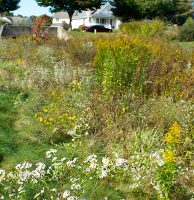
Dr. Doug Tallamy and LandStudies Recognize the Value of Native Plants for Pollinators
Dr. Doug Tallamy is the distinguished professor of ecology at the University of Delaware renowned for his research on the ecosystem services of plants. His best-selling books Bringing Nature Home and The Living Landscape: Designing for Beauty and Biodiversity in the Home Garden, highlight the impact of dwindling natural habitats and the importance of our backyards as refuges for native plants, wildlife, and insects.
During a presentation in March of 2018, Tallamy successfully persuaded a standing room only crowd of municipal/legislative officials and the public at Franklin & Marshall College that we need to be mindful of protecting and nurturing native plant communities that support our ecosystem. Through his research, he has documented that native plants are best suited to support the insects necessary for survival of the natural world as we know it.
What does that mean for Pennsylvania? Through his books and lectures, Tallamy encourages everyone to use more native plants in their yards and landscapes to provide the food and shelter that butterflies, birds, and other species need to survive. For instance, most native caterpillars, the primary food source for birds, cannot eat the exotic ornamental plants that dominate yards and gardens across the Commonwealth. Native plants like milkweed, asters, and violets provide that food source to butterflies, bees, and other insects, which then keep our birds well-fed and happy.
Unfortunately, due in large part to a reduction in native plant habitats, parasites, and the use of pesticides native pollinators like butterflies and honey bees are on a decline. Since nearly 35 percent of crops grown worldwide depend on pollinators this has become a threat to the agricultural industry and food security, according to an article in The New York Times. Without pollinator species, our food choices would be cut dramatically, affecting millions of jobs and billions of dollars annually.
LandStudies’ sustainable design services incorporates pollinator species into the design of our projects through the establishment of native plants. Read more in our article, Native Plants Are a Valuable Addition to Your Landscape.
We recently toured one of LandStudies’ projects, The Homes at Wyncote, with Dr Tallamy as a demonstration for how native plant habitat could be better integrated into a suburban development. The project, developed over the past 20 years, provides a unique model for the integration of meadows and reforestation into a conventional development. On average, the lawn area has been reduced by 50% and over 20 acres of warm season grass meadows and reforestation have been established. Dr Tallamy was impressed with the biodiversity present on the site and was particularly encouraged by the sighting of a Bobolink in one of the meadows. Bobolinks are a threatened songbird species that requires bio-diverse open meadows and grasslands for survival.
LandStudies’ more than 20 years of involvement with The Homes at Wyncote includes developing the initial master plan, developing the native landscape guidelines, working with many of the individual homeowners, and designing and installing the initial meadows and reforestation. This has resulted in a unique model for sustainable development that could be replicated within other conventional housing developments throughout the state. This example illustrates how new neighborhoods do not have to be devoid of life and follow the old suburban landscapes dominated by non-native ornamental plants and lawns. It demonstrates that native landscaping can provide habitat without sacrificing function and beauty as well.
Planting more native species is something that everyone can do to encourage pollinator species establishment and its linkage to supporting other life forms that are crucial to our ecosystems and communities as a whole.
For additional pollinator-friendly resources visit Penn State Extension’s Center for Pollinator Research.


